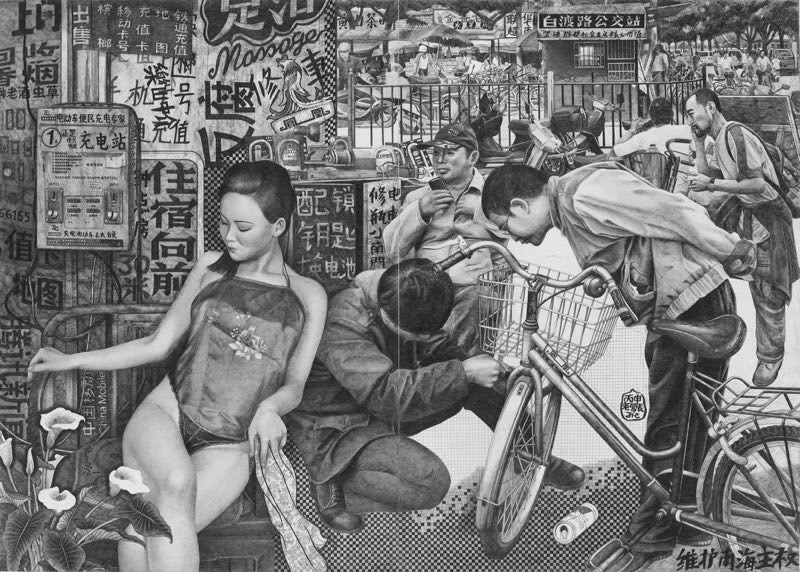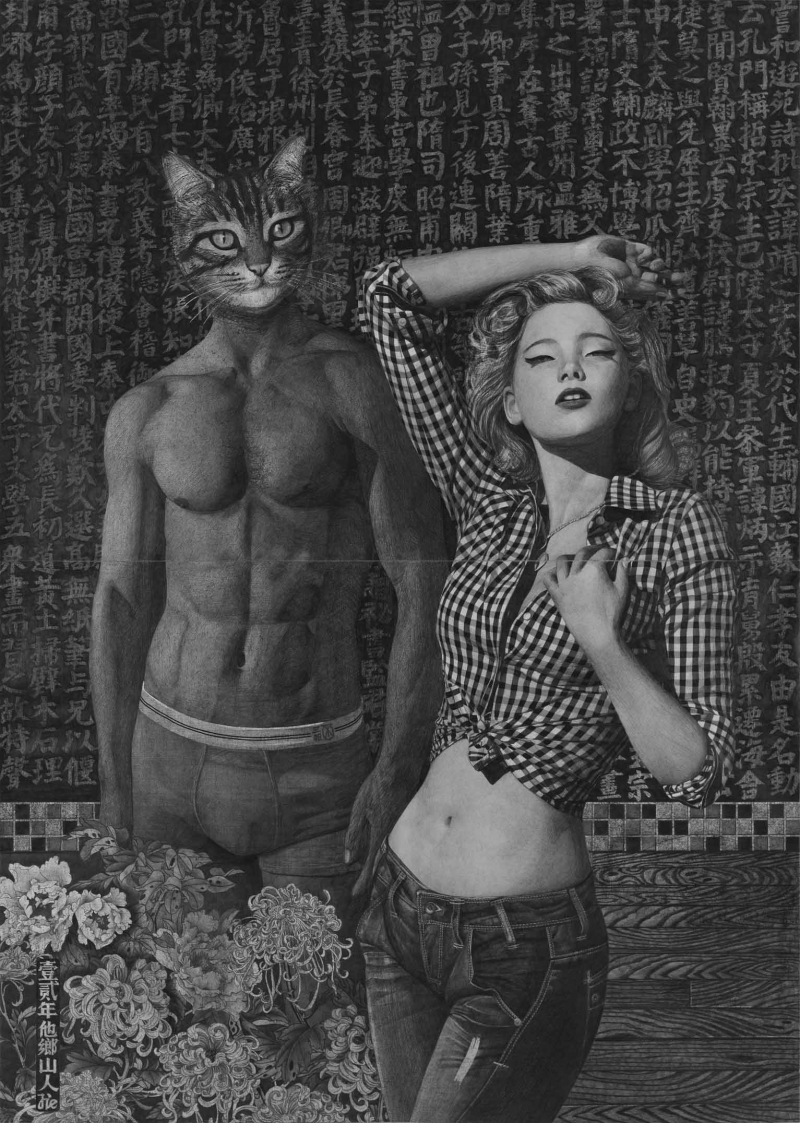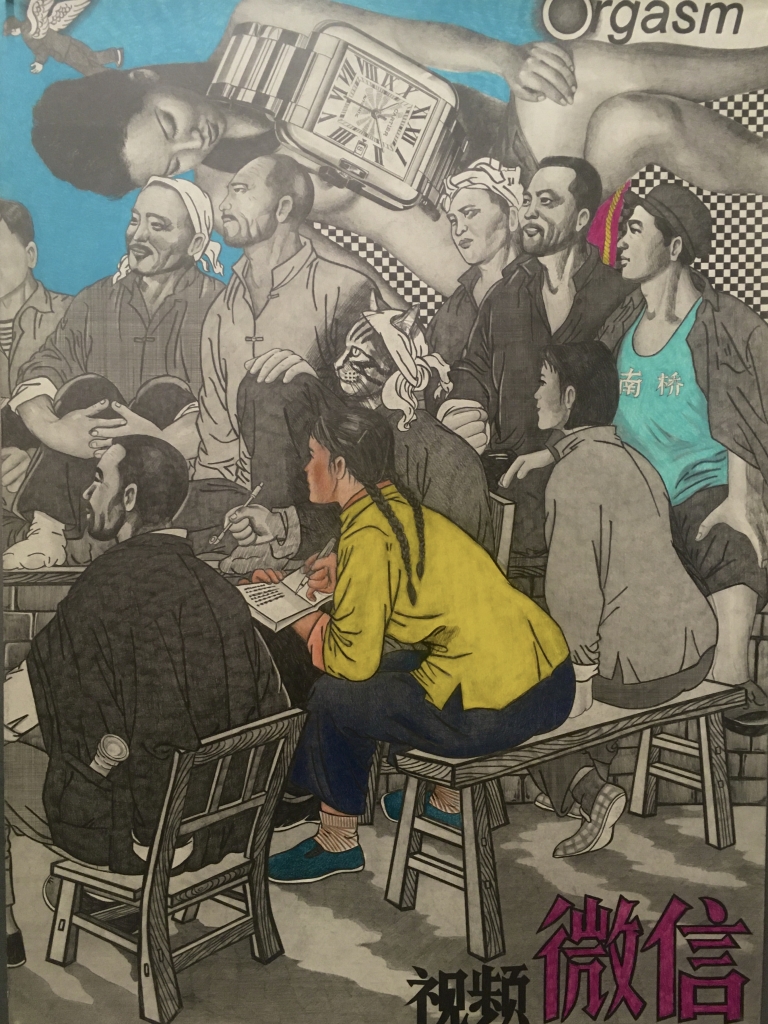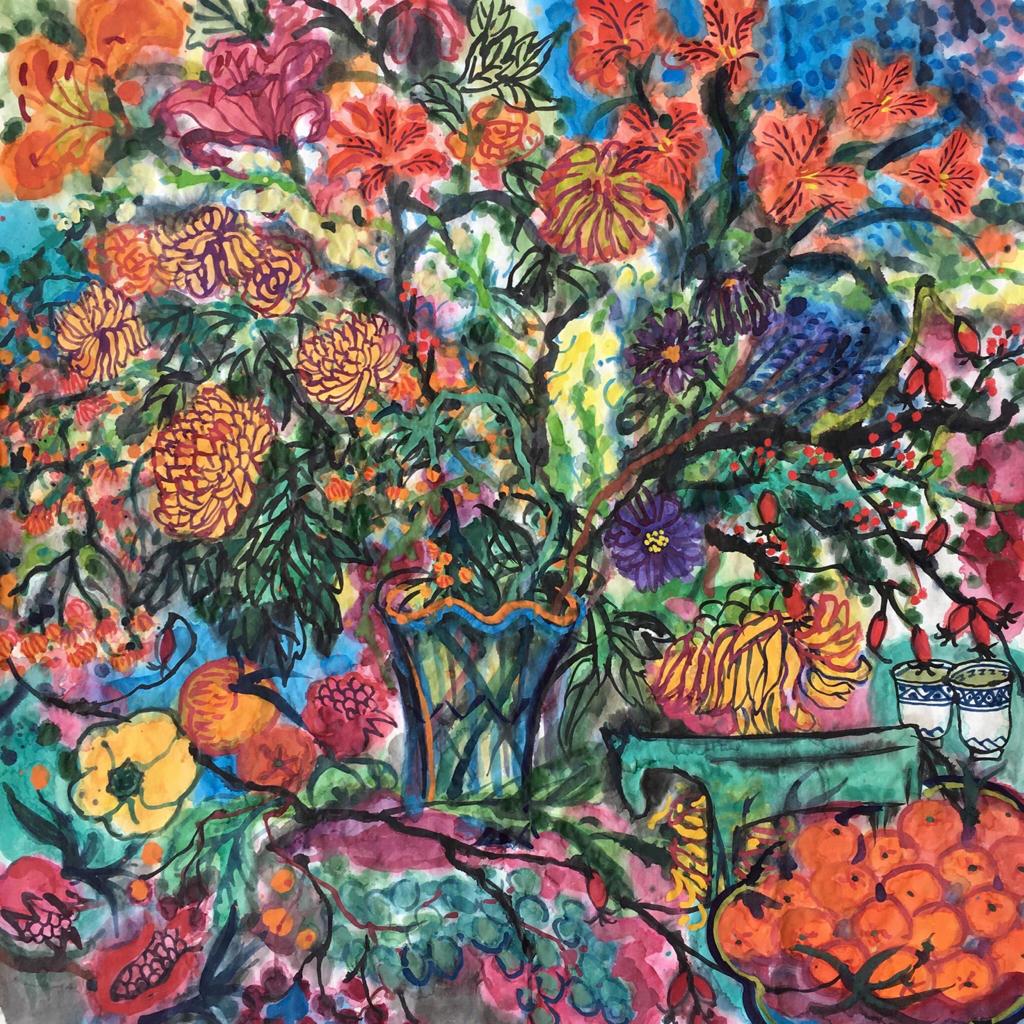« SHANGHAI SONG »
QIU Jie , Solo Exhibition (Drawings and paintings)
16 January – 5 April 2020
Opening in presence of the artist
Thursday 16th January, 2020, 7-9 PM

Qiu Jie, das Velo (Fahrrad)Pencil drawing (Bleistiftzeichnung), 100x140cm

Qiu Jie, Three Guns, 2012, Pencil on Paper (Bleistiftzeichnung auf Papier l Mine de plomb sur dessin), 140x100cm

Qiu Jie, Montre et couleurs (die Uhr und Farbe), 2019, DaZiBao, Pencil on Paper (Bleistiftzeichnung auf Papier), 82x60cm

Qiu Jie, Chinese painting. Watercolour and Chinese ink (Tusche & Aquarell), 70x70cm, 2015-2019
« SHANGHAI LIED »
„India Song“ ist ein Film von Marguerite Duras, der die siebziger Jahre charakterisiert. Es ist der erste Film über die Reminiszenz der Erinnerungen und Illusionen.
Qiu Jie, lebt in Genf und Shanghai; er zeichnet und malt eine Welt, in der sich viele Erinnerungen kreuzen.
Qiu Jie greift in seiner Arbeit die Geschichte seines Lebens auf; das heißt, er teilt die prägendsten Momente seines Lebens mit dem, der seine Bilder betrachtet.
Die Hinweise auf die Kulturrevolution und ihre Propaganda-Instrumente sind ebenso offensichtlich wie die von Ironie und Kontrasten geprägte Seite des „Political Pop“. Bei genauer Betrachtung kann man eine echte Sehnsucht des Künstlers nach seinem Land, sogar während jener Zeit, wahrnehmen.
Qiu Jie, geprägt vom Konfuzianismus, der den sozialen Realismus und die Moral betont, sowie vom Taoismus, der der Natur und der Gelassenheit einen wesentlichen Platz einräumt, verwischt ständig die Bilder zwischen Vergangenheit und Gegenwart, Ost und West, der traditionellen und zeitgenössischen Kunst. So entsprechen einige seiner Blumendarstellungen nicht mehr denen der traditionellen chinesischen Malerei, sondern den Blumen unseres Klimas; so wie die Pfingstrose, die „Königin der Blumen“ oder „Fuguihua“ (Fu / Reichtum und Mistel / Wert).
Damit wir seinen Gedankengängen folgen können, fügt Qiu Je den anspruchsvollen Symbolen der klassischen, chinesischen Malerei, wie Berge und Wasser, volkstümliche Gebrauchsgegenstände wie Teekannen und Schalen für Teezeremonien hinzu, aber auch Kontrapunkte wie Handys als Zeichen der Banalität des täglichen Lebens.
Qiu Jie beherrscht alle Maltechniken von der Bleistiftzeichnung bis zur Ölmalerei. In seinen Aquarellen und Tuschezeichnungen spielt er mit hellen und lebendigen Farben, womit er sich dem Maler Wu Dayu (1903 – 1988) annähert. Von diesem sagt man, dass „das fließende Blau, zu dem das helle Rot und das helle Gelb hinzugefügt werden, eine rhythmische Palette bilden. Der Maler vereint in seinem flüssigen Pinselstrich das Wesentliche der chinesischen Kalligraphie und des westlichen Stils. “
Qiu Jie, „der Mann, der von anderen Bergen abstammt“, präsentiert sich während eines Interviews als chinesischer Hippie, wegen seiner Vorliebe für Provokation und seiner Äußerung von Zweifeln. Er ist sowohl ein Gebildeter dem chinesischen Verständnis nach, als auch ein Romantiker im westlichen Sinne.
Wie für Marguerite Duras in „India Song“ ist das Leben für Qiu Jie ein Gewirr vergangener und gegenwärtiger Stimmen und Emotionen, ein ständiges Hin und Her zwischen Kulturen und Epochen, die sie geprägt haben.
Vielleicht sind das sehr präsente Rot und die Sinnlichkeit der weiblichen Figuren im Werk von Qiu Jie ein Wiederaufgreifen der Figur der Anne-Marie Stretter in Marguerite Duras‘ Film, die in ihrem roten Kleid für Provokation und Gefahr steht.
« SHANGHAI SONG »
«India Song», film de Marguerite Duras, marque les années soixante-dix comme le premier film sur la réminiscence des souvenirs et des illusions.
Qiu Jie vit entre Genève et Shanghai; il dessine et peint un monde dans lequel se croisent bien des mémoires.
Qiu Jie inscrit dans son travail l’histoire de sa vie dont il partage les moments les plus forts avec qui regarde ses œuvres de près.
Les références à la révolution culturelle et à ses outils de propagande sont évidents, ainsi que le côté «Political Pop» plein d’ironie et de contrastes. Une attention plus soutenue amène à percevoir aussi une vraie nostalgie de son pays et de sa jeunesse durant la révolution culturelle.
Qiu Jie, marqué tant par le confucianisme qui met l’accent sur le réalisme social et la moralité, que par le taoïsme qui donne une place essentielle à la nature et la sérénité, brouille constamment les images entre passé et présent, orient et occident, art traditionnel et art contemporain. Ainsi certaines de ses fleurs ne sont plus celles de la peinture traditionnelle, mais des fleurs de nos climats comme la pivoine, la reine des fleurs ou «fuguihua» (fu / la richesse et gui/ la valeur).
Pour nous permettre de suivre le jeu de piste de son parcours, au milieu des symboles lettrés de la peinture chinoise classique, dont la montagne et l’eau, Qiu Jie insère des objets folkloriques tels que théières et bols pour la cérémonie du thé mais également, en contrepoint, des téléphones portables, marques de la banalité du quotidien.
Qiu Jie maitrise toutes les techniques picturales du dessin au crayon à la peinture à l’huile en passant par l’aquarelle et l’encre de chine avec lesquelles il joue de la lumière et des couleurs éclatantes qui le rapprochent du peintre Wu Dayu (1903-1988), dont on disait que «le bleu fluide, le rouge éclatant et le jaune clair constituent une palette rythmée. Le peintre combine ainsi dans ses touches fluides l’essentiel de la calligraphie chinoise et du style occidental».
Qiu Jie, «l’homme qui descend d’autres montagnes» se présente comme un hippie chinois lors d’une interview, pour son goût de la provocation et de l’exercice du doute ; il est aussi fin lettré, dans la compréhension chinoise du terme, que romantique, dans le sens occidental.
Comme pour Marguerite Duras dans «India Song», la vie pour Qiu Jie est un enchevêtrement de voix et d’émotions passées et présentes, un aller et retour permanent entre des cultures et des époques qui l’ont marqué.
Peut-être le rouge très présent dans son œuvre, comme la sensualité des personnages féminins de Qiu Jie font-ils une reprise du film de Marguerite Duras qui montrait Anne-Marie Stretter vêtue d’une robe rouge, couleur de provocation et de danger…
« SHANGHAI SONG »
„India Song“, a movie by Marguerite Duras, left a lasting impression in the 1970s as the first film about the reminiscence of memories and illusions.
Qiu Jie lives between Geneva and Shanghai; he draws and paints a world in which many memories intersect.
In his work, Qiu Jie writes the story of his life, the strongest moments of which he shares with whom takes a close look at his work.
The references to the cultural revolution and its propaganda instruments are just as obvious as his usage of „political pop“, characterized by irony and contrasts. More sustainable attention leads to perceive a real nostalgia for his country and for his youth during the cultural revolution.
Qiu Jie, influenced by Confucianism, which emphasizes social realism and morality, as well as by Taoism, which confers an essential place to nature and serenity, constantly blurs images, between past and present, East and West, traditional and contemporary art. Some of his flowers are no longer those of traditional paintings, but rather flowers of our latitudes, such as the peony, the queen of flowers or „Fuguihua“ (Fu / Wealth and Mistletoe / Value).
In order to enable us to follow the treasure hunt of his journey, Qiu Jie inserts in his paintings among sophisticated symbols of classic Chinese painting such as mountains and water, folk objects like teapots and bowls for the tea ceremony as well as, in counterpoint, cell phones, symbols of the mundanity of everyday life.
Qiu Jie masters all artistic techniques from pencil drawing to oil painting, including watercolor and Chinese ink, with which he plays with light and vivid colors. Those bring him closer to the painter Wu Dayu (1903 -1988), who was said to have „that liquid blue, bright red and light yellow which form a rhythmic palette. The painter thus combines the essence of Chinese calligraphy and Western style in his fluid strokes”.
Qiu Jie, „the man who descends from other mountains“, presents himself as a Chinese hippie during an interview because of his penchant for provocation and the pursuit of doubt. He is a scholar in the Chinese understanding of the term, as well as a romantic in the Western sense.
As for Marguerite Duras in „India Song“, life for Qiu Jie is a tangle of past and present voices and emotions, a constant back and forth between cultures and epochs that have shaped him.
Perhaps the color red, very present in Qiu Jie’s work, as the sensuality of his female characters, provide for a remake of Duras’ movie, which showed Anne-Marie Stretter in a red dress, the color of danger and provocation.
